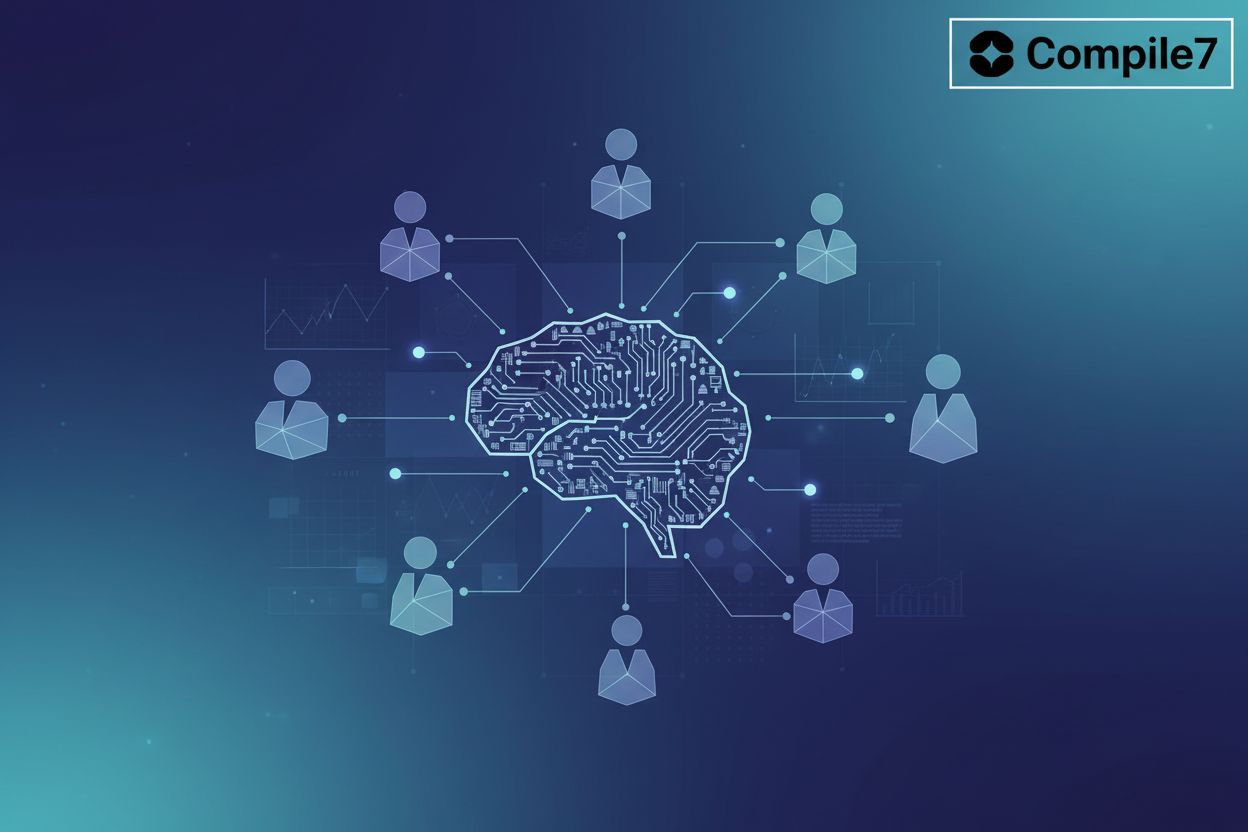Federated Learning for Decentralized AI: A Comprehensive Guide for Business Leaders
Understanding Federated Learning: The New Paradigm for AI
Federated Learning (FL) is revolutionizing ai, but how does it actually work for businesses? For businesses, this means unlocking ai's potential without the risk and cost of centralizing sensitive customer or proprietary data. Imagine training powerful ai models without ever needing to access raw, sensitive data. That's the promise of Federated Learning.
Federated Learning is a decentralized approach where machine learning models are trained across multiple devices or organizations. The key benefit? Data remains localized, bolstering privacy and security. Instead of sharing raw data, model updates are shared for global model aggregation. This enables collaborative ai development without centralizing sensitive data, offering a new paradigm for privacy-preserving ai.
- Decentralized Approach: Train ML models across multiple devices or organizations.
- Data Localization: Data remains on the device or within the organization, ensuring privacy and security.
- Model Updates: Only model updates are shared, not raw data, which ensures global model aggregation.
- Collaborative AI: Enables ai development without centralizing sensitive data. Collaborative ai development means multiple organizations can jointly build more robust and accurate ai models than any single entity could achieve alone, fostering innovation and shared expertise.
For business leaders, Federated Learning offers a range of compelling advantages. Enhanced data privacy compliance with regulations like GDPR and HIPAA, is a major draw. It also reduces data transfer costs and bandwidth usage, as well as improve model performance through diverse datasets. Improved model performance through diverse datasets: Access to a wider range of data from different sources helps models generalize better to unseen data and reduces the risk of bias inherent in single-source datasets. Finally, it increases user trust and adoption due to its privacy-preserving nature, and scalability to handle massive datasets across numerous devices or organizations.
- Privacy Compliance: Enhanced data privacy compliance with regulations like GDPR and HIPAA.
- Cost Reduction: Reduced data transfer costs and bandwidth usage.
- Model Performance: Improved model performance through diverse datasets.
- User Trust: Increased user trust and adoption due to its privacy-preserving nature.
While traditional Federated Learning often relies on a central server for model aggregation, this creates a potential bottleneck and single point of failure. Decentralized Federated Learning eliminates the central server, enhancing robustness and scalability. Decentralized approaches often involve peer-to-peer communication and blockchain integration for secure model sharing and governance.
Understanding the nuances between centralized and decentralized approaches is crucial for choosing the right strategy. While traditional FL often relies on a central server, the following section will explore the architecture and workflow of decentralized Federated Learning, which offers enhanced robustness and scalability.
The Architecture and Workflow of Decentralized Federated Learning
Did you know that decentralized federated learning can enhance data privacy and security compared to traditional methods? Let's explore how this innovative approach can revolutionize ai for your business.
Decentralized Federated Learning (FL) systems involve several key components working together. These components ensure data privacy, security, and efficient model training across multiple devices or organizations.
- Participants (Clients): These are devices or organizations with local data and computational resources. Think of hospitals with patient data, retail stores with transaction records, or financial institutions with customer information.
- Communication Network: This infrastructure enables model update sharing. Options include peer-to-peer networks or blockchain, providing secure and direct communication channels Decentralized AI Model Training Using Federated Learning and Blockchain in Cloud Environments.
- Aggregation Mechanism: This algorithm combines model updates from different participants. Techniques like federated averaging or secure aggregation ensure the global model learns from diverse data without compromising privacy.
- Incentive Mechanism: This rewards participants for contributing high-quality data and computational resources. Tokenization or reputation systems can encourage active participation and data integrity Decentralized AI Model Training Using Federated Learning and Blockchain in Cloud Environments.
The workflow in a decentralized setting involves a series of steps to train a global model collaboratively. Each step ensures data privacy and efficient model aggregation.
- Initialization: Participants agree on a global model architecture and initial parameters. This ensures everyone starts from the same foundation, facilitating effective collaboration.
- Local Training: Each participant trains the model on their local data. This decentralized approach allows training without centralizing sensitive data.
- Model Sharing: Participants share their model updates with selected peers, using protocols like gossip protocols or blockchain. This peer-to-peer sharing enhances robustness and scalability.
- Aggregation: Each participant aggregates the received model updates with their local model. This step combines insights from multiple sources, improving model accuracy and generalization.
- Iteration: The process repeats until the model converges or a predefined stopping criterion is met. This iterative approach refines the model over time, ensuring optimal performance.
Understanding these components and workflow steps is crucial for implementing decentralized Federated Learning effectively. In the next section, we'll dive into the specific applications of Federated Learning across various industries.
Enhancing Privacy and Security in Federated Learning
Enhancing data privacy and security is paramount in Federated Learning. Several techniques can be employed to ensure that sensitive information remains protected during the collaborative training process. Let's explore some of these methods.
Differential Privacy is a technique that adds noise to model updates. This prevents the inference of individual data points, thus protecting sensitive information. DP balances privacy guarantees with model accuracy, ensuring that the added noise doesn't significantly degrade the model's performance.
- DP-SGD: This method applies differential privacy to Stochastic Gradient Descent, adding noise to the gradients during local training on each participant's device before they are shared.
- DP-FedAvg: This technique combines differential privacy with the Federated Averaging algorithm. It is a popular method for aggregating model updates in a privacy-preserving manner.
Secure Aggregation involves cryptographic protocols for secure aggregation of model updates. This is done without revealing individual contributions. These protocols use techniques like homomorphic encryption and multi-party computation (MPC).
- Homomorphic Encryption: This allows computations to be performed on encrypted data without decrypting it. This ensures that the server can aggregate model updates without accessing the underlying data.
- Multi-Party Computation (MPC): This enables multiple parties to jointly compute a function over their inputs while keeping those inputs private. MPC can be used to securely aggregate model updates without revealing individual contributions.
Ensuring robustness against malicious participants and data poisoning attacks is another key aspect of Secure Aggregation. This can involve techniques like verifiable computation to ensure that participants are contributing valid updates. Verifiable computation allows the central server (or other participants) to check if the computations performed by a participant on their local data were done correctly, preventing them from submitting malicious or incorrect updates.
Zero-Knowledge Proofs are used to verify the integrity of model updates. This is done without revealing the underlying data or model parameters. ZKPs ensure that participants are contributing valid and trustworthy updates.
- Integrity Verification: ZKPs verify that the model updates are generated according to the specified training process. This is done without revealing any information about the training data.
- Transparency and Accountability: ZKPs enhance transparency and accountability in the federated learning process. This ensures that all participants can trust the integrity of the model updates.
By incorporating these privacy and security enhancements, organizations can confidently deploy federated learning solutions. This allows them to collaborate on ai model training without compromising sensitive data. In the next section, we'll explore the diverse applications of Federated Learning across various industries.
Federated Learning with Blockchain: A Synergistic Approach
Blockchain technology can revolutionize federated learning, but how exactly? By integrating blockchain, Federated Learning systems can benefit from enhanced security, transparency, and decentralization.
Blockchain technology offers unique advantages when integrated with decentralized Federated Learning (FL):
- Providing a secure and transparent platform for model sharing and aggregation. Blockchain's immutable ledger ensures that model updates are securely recorded and verifiable. This prevents tampering and enhances trust among participants.
- Enabling decentralized governance and incentive mechanisms. Blockchain-based smart contracts can automate governance processes, ensuring fair participation and reward distribution. This fosters a more equitable and sustainable FL ecosystem.
- Ensuring data immutability and auditability. Each transaction on the blockchain is permanent and auditable. This creates a transparent record of all model updates and contributions, enhancing accountability.
- Facilitating trust among participants in a decentralized setting. By providing a secure and transparent platform, blockchain eliminates the need for a central trusted authority, fostering trust among diverse participants.
Smart contracts, self-executing agreements written in code, are key to automating governance in Federated Learning:
- Automating the execution of federated learning protocols. Smart contracts can define and enforce the rules of the FL process, ensuring that all participants adhere to the agreed-upon protocols.
- Enforcing data quality and contribution requirements. These contracts can verify the quality and relevance of data contributions, ensuring that only high-quality data is used for training.
- Distributing rewards based on performance and participation. Smart contracts can automatically distribute tokens or other incentives to participants based on their contributions and the model's performance.
- Managing access control and permissions. They can control who has access to the model and data, ensuring that only authorized parties can participate in the FL process.
Tokenization introduces various incentive mechanisms to encourage participation and ensure data quality:
- Rewarding participants with tokens for contributing data and computational resources. Participants earn tokens based on the value of their contributions, encouraging active participation.
- Staking mechanisms for ensuring data quality and preventing malicious behavior. Participants stake tokens as collateral, which can be forfeited if they submit low-quality data or engage in malicious activities.
- Governance tokens for enabling decentralized decision-making. These tokens allow participants to vote on key decisions related to the FL process, such as model updates and protocol changes. Utility tokens can be used to pay for computational resources or access to the aggregated model, while governance tokens grant holders voting rights on protocol upgrades.
- Creating a sustainable and equitable ecosystem for federated learning. By rewarding participants fairly and ensuring data quality, tokenization creates a sustainable and equitable environment for collaborative ai development.
Understanding how Federated Learning integrates with blockchain offers a glimpse into the future of secure and decentralized ai. Next, we'll explore real-world applications of Federated Learning across various industries.
Compile7: Revolutionizing AI with Custom AI Agents
Are you looking to revolutionize your business with ai? Custom ai agents can automate tasks, enhance productivity, and transform operations in ways you never thought possible.
Compile7.com specializes in developing custom ai agents tailored to your specific business needs. Rather than using off-the-shelf solutions, they tailor ai solutions to match your unique workflows, ensuring seamless integration and maximum impact. This approach leverages cutting-edge ai technologies and machine learning algorithms for superior performance.
Here are some key benefits of using Compile7.com for custom ai development:
- Develop custom ai agents that automate tasks, enhance productivity, and transform how your business operates.
- Tailor ai solutions to specific business needs and workflows.
- Leverage cutting-edge ai technologies and machine learning algorithms.
Compile7.com offers a range of ai-powered solutions designed to tackle various business challenges. From customer service to data analysis, their ai agents can significantly improve efficiency and outcomes.
Here are some examples of ai Agents:
- Customer Service Agents: Automate customer interactions and provide personalized support.
- Data Analysis Agents: Extract insights from complex datasets and generate actionable reports.
- Content Creation Agents: Generate high-quality content for marketing, social media, and other channels.
- Research Assistants: Automate research tasks and accelerate the discovery process.
- Process Automation Agents: Streamline business processes and reduce manual effort.
- Industry-Specific Agents: Custom ai agents tailored to the unique needs of various industries. For example, a healthcare agent might train on patient data across hospitals without direct data access to identify potential disease outbreaks early.
Business automation is at the heart of Compile7's mission. By automating repetitive tasks, ai agents free up human resources for more strategic initiatives. This not only improves efficiency and reduces operational costs but also enhances accuracy and consistency in business processes.
- Automate repetitive tasks and freeing up human resources for more strategic initiatives.
- Improving efficiency and reducing operational costs.
- Enhance accuracy and consistency in business processes.
- Transform how your business operates with ai.
By automating these processes, businesses can achieve significant cost savings and improve overall productivity.
It's important to consider ethical implications when implementing ai solutions. Data privacy, algorithmic bias, and potential job displacement are crucial factors to address responsibly. Transparency and fairness should be guiding principles in ai deployment.
Now that you understand the potential of custom ai agents, let's explore the real-world applications of Federated Learning across various industries.
Real-World Applications and Case Studies
Did you know that Federated Learning is already making waves across industries? Let's dive into some real-world applications and case studies that highlight its transformative potential.
- Federated Learning enables training diagnostic models across multiple hospitals, such as for early cancer detection, without sharing sensitive patient data. This is especially critical given strict regulations like HIPAA.
- By using diverse datasets from various institutions, the accuracy and generalizability of medical ai systems can be significantly improved. As Lu, M. Y. et al. noted in their 2022 study, Federated Learning is invaluable for computational pathology on gigapixel whole slide images.
- This collaborative approach accelerates medical research and drug discovery, leading to faster advancements in patient care.
Federated learning provides a collaborative environment that respects data privacy and regulatory boundaries.
In the financial sector, Federated Learning is used to detect fraudulent transactions across multiple banks by analyzing transaction patterns without exposing individual account details. This collaborative approach enhances security and stability.
It helps to improve risk assessment and compliance, ensuring the financial system remains secure and stable.
Federated Learning allows training ai models on edge devices. It aims to improve the efficiency and responsiveness of smart city applications.
By analyzing sensor data from multiple sources without centralizing sensitive information, Federated Learning enables real-time decision-making and automation. For instance, it can optimize traffic flow by analyzing anonymized GPS data from vehicles or predict energy consumption patterns based on smart meter readings across neighborhoods. Zhao Yang et al. highlighted the importance of local differential privacy-based Federated Learning for the Internet of Things in a 2021 paper.
Federated Learning allows for collaborative ai development without compromising data privacy or security.
These examples illustrate how Federated Learning is revolutionizing industries. In the next section, we'll discuss the challenges and future trends in Federated Learning.
Challenges and Future Directions
As Federated Learning matures, it faces hurdles that require innovative solutions. Overcoming these challenges is crucial for unlocking its full potential across various sectors.
Communication Overhead is a significant bottleneck. Reducing the amount of data transferred between participants is essential for efficiency, especially in environments with limited bandwidth. This can involve techniques like model compression or quantization.
Heterogeneous Data presents complexities because variations in data distribution and quality across different participants can affect model performance. Strategies like data standardization or personalized FL approaches can help.
System Reliability must be ensured to maintain robust client participation. This involves handling device failures and intermittent connectivity effectively.
Scalability is vital for efficiently scaling Federated Learning to millions of devices. This requires optimized algorithms and infrastructure to handle increased computational demands. Efficient communication protocols and distributed training frameworks are key here.
Security is paramount, and ensuring robust security measures to protect model updates and prevent adversarial attacks is crucial for trust and reliability.
Regulatory Compliance is essential, and adhering to data protection regulations across different regions is necessary to avoid legal issues and maintain ethical standards.
Incentive Design is important for encouraging participation, and creating fair and effective incentive mechanisms to encourage contributions is key to a sustainable ecosystem.
Governance is needed for clear decision-making. Establishing clear governance structures for decentralized decision-making ensures fair and transparent operations.
Developing more efficient communication protocols is critical.
Designing robust aggregation algorithms for heterogeneous data will improve model accuracy.
Exploring new privacy-enhancing technologies will strengthen data protection.
Creating more scalable and decentralized governance models will promote broader adoption.
Federated Learning is poised to transform ai, but addressing these challenges will pave the way for more secure, efficient, and scalable solutions.





